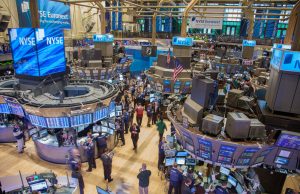The Future of the Stock Market: Emerging Technologies and Market Disruptions
In the heart of New York City, just a stone’s throw from where the legendary Wall Street bustles with finance professionals, lies a less conspicuous yet equally significant symbol of financial evolution. This is the story of a young trader, Sarah, who, not so long ago, walked onto the floor of the New York Stock Exchange for the first time. Amid the chaos of shouts and the frantic waving of hands, she was introduced to a world where fortunes were made and lost in minutes. Yet, today, Sarah trades from the quiet of her apartment, her decisions informed by cutting-edge technologies that would have been unfathomable just a decade ago. This transformation from the bustling trading floors to sophisticated digital platforms encapsulates the seismic shift in the stock market landscape, a shift primarily driven by emerging technologies.
As we delve into the current state of the stock market, it’s essential to recognize that it has always been a dynamic entity, constantly evolving with technological advancements. Gone are the days when the market was a place of physical exchange, reliant on the speed and efficiency of human traders. Today, it’s a digital battlefield where algorithms, artificial intelligence (AI), and cloud computing reign supreme.
Historical Context and Current Scenario:
Take the Indian stock market, for instance. A few decades ago, traders relied on hand signals and vocal strength to execute trades. A thumbs-up indicated 50 shares to trade, while the orientation of the palm signaled buying or selling. The market was a theater of physical presence and loud voices, especially in the trading ring of the Bombay Stock Exchange (BSE), Asia’s oldest stock exchange.
Fast forward to today, and it’s a vastly different story. Indian capital markets are among the most technologically advanced, with a move towards a T+1 settlement cycle – a feat yet to be achieved by more developed markets like the United States, which still operates on a T+2 cycle. This rapid settlement process is not just a convenience; it’s a testament to the power of technology in revolutionizing market operations.
Similarly, advancements in technology have reshaped market access and participation. IIFL Securities’ Chief Digital Officer, Nandkishore Purohit, notes the emergence of instant account opening and the rise of niche trading platforms. These innovations have democratized investing, evidenced by the entry of a record 16 million new investors in the Indian market from January to November 2021 alone. The ease and speed of digital onboarding have extended market participation beyond traditional financial centers to the hinterlands, fundamentally changing who trades and how.
Key Emerging Technologies Reshaping the Stock Market:
The technological transformation of the stock market is not just about faster transactions or wider access. It’s about fundamentally redefining the way market operations are conducted. Here are some key technologies at the forefront of this revolution:
- Digital Immune Systems: These are not just software tools but comprehensive frameworks that autonomously identify and mitigate operational and security risks in real-time. Imagine a stock market that’s not only efficient but also robust against various forms of digital threats.
- Applied Observability: This concept is rooted in data analytics and AI, offering enterprises insights to optimize operations. In the stock market, this means leveraging vast amounts of data to make informed, efficient, and future-proof decisions.
- AI Trust, Risk, and Security Management: As AI becomes more prevalent in trading and investment advisory, addressing its ethical and security implications is paramount. These technologies, while potent, carry their own set of challenges that must be navigated with care.
- Industry Cloud Platforms: The migration of corporate data to the cloud has been nothing short of revolutionary. For the stock market, this translates into more secure, reliable, and agile operations, tailoring cloud solutions to specific industry needs.
- Platform Engineering: This emerging technology aims to empower developers and end-users with self-service capabilities, enhancing productivity and reducing the load on software development teams. It’s about making technology not just powerful but also accessible and user-friendly.
These technologies are not mere incremental improvements; they are catalysts for a paradigm shift in how the stock market operates. They’re redefining the very essence of trading and investing, making them more accessible, efficient, and secure.
Case Studies: Real-World Applications and Predictions:
Real-world applications of these technologies are not hard to find. For example, we’re already seeing the implementation of AI in automated trading algorithms. These algorithms, or ‘algos’, as they are colloquially known, execute trades based on pre-set parameters, minimizing human error and emotion in trading decisions. Nearly 50% of trades in some markets are now conducted through algos. What’s more, these technologies are making inroads into the retail investor space, signaling a democratization of sophisticated trading tools previously reserved for institutional investors.
Wireless Value Realization and the Rise of Superapps:
In the realm of wireless technology, we’re witnessing an evolution beyond mere connectivity. New wireless capabilities like location tracking, radar sensing, and vehicle-to-vehicle communication are propelling businesses towards a digital future, significantly impacting the stock market through advanced trading and monitoring tools.
Superapps, akin to digital Swiss army knives, amalgamate a plethora of miniapps, offering a comprehensive platform for trading, analysis, and market insights. These apps are transforming how investors interact with the stock market, making it more integrated and versatile.
The Metaverse and Sustainable Technology:
The potential rise of the metaverse, predicted to reach a market value of over $936 billion by 2030, is another game-changer. This immersive 3D platform could revolutionize the way investors interact, analyze, and trade, offering a more engaging and interactive experience.
Sustainable technology also plays a crucial role, offering digital solutions that drive environmental, social, and governance (ESG) outcomes. This technology is becoming increasingly relevant as the global focus shifts towards sustainable investing.
Conclusion:
In conclusion, the stock market of the future is not a distant dream but an evolving reality. The rapid adoption of technologies like digital immune systems, applied observability, AI, and the cloud is fundamentally altering the landscape of trading and investment. These advancements promise a future where the stock market is more accessible, efficient, and secure, catering to a broader spectrum of investors.
However, as we embrace these innovations, we must also be cognizant of the challenges they bring, such as scalability, data security, and ethical considerations. The journey ahead is exciting but requires cautious navigation.
As I have often said, staying ahead of the curve in the financial world is not just about understanding the market’s current state but anticipating its future. And if there’s one thing certain about the future, it’s that technology will continue to be its primary driver.












